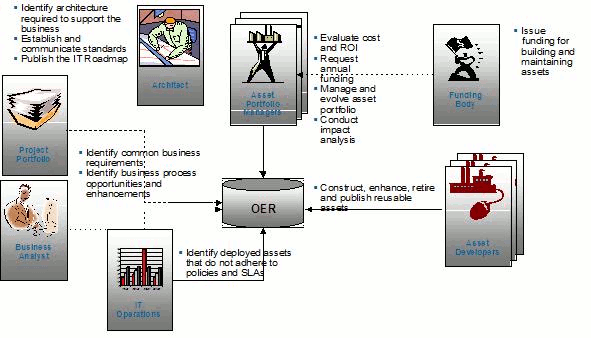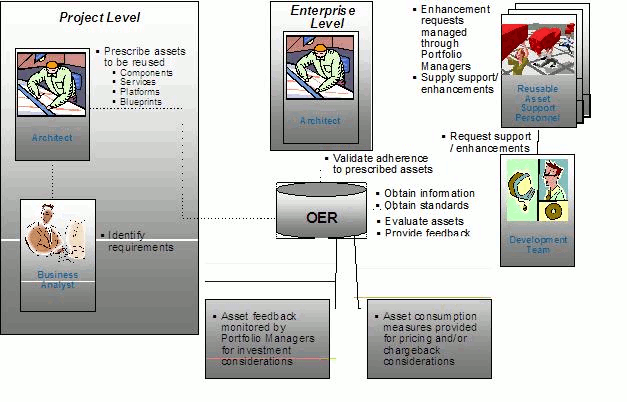







|
This chapter contains information on the following topics:
The Oracle Enterprise Repository provides integration within development environments so developers can easily search for and use assets from the repository without leaving their developent environment. Assets and any associated artifacts are downloaded directly to the developer’s workspace. Integration also provides a convenient way to submit or harvest assets from the development environment into the Oracle Enterprise Repository for use throughout the enterprise.
Repository Access within the developer’s workspace also provides a view into Oracle Enterprise Repository that enables developers to, download artifacts and assets from the repository, query the repository, and view the contents of the repository.
The goal of this integration is to ensure that SOA Governance becomes part of the fabric of every day development.
This section describes the following best practice processes:
Oracle Enterprise Repository is used to track new assets and asset enhancements from the time they are proposed through the retirement of the assets, which also includes the time when the assets are being developed and when the assets are completed. Through Oracle Enterprise Repository, assets are used to produce and consume projects, to provide traceability and support impact analysis, and to point out project-level impacts of changes to the asset release plans.
Initially, a business analyst provides a description of the functionality that needs to be produced. If determined that the proposed functionality does not already exist, then an architect provides the functional designs and non-functional requirements. The development team then produces, harvests, or enhances an asset that meets the functional and non-functional requirements.

This means that the development team needs visibility into the assets that they are to produce such as the requirements, use cases and so on. Oracle Enterprise Repository provides that visibility by allowing developers to view an asset details of an asset directly from the development environment. The development team builds the specified asset and then harvests the asset into the Oracle Enterprise Repository, where it goes through a review and approval process. Figure 1-1 describes a sample asset production process.
The production and enhancement of assets can be governed through design-time policies. Policies are applied to assets in order to communicate asset requirements that need to be considered during design and development, and to provide administrators with the means to enforce and monitor asset compliance with governance, architecture, and other organizational standards. For example, a policy might articulate corporate quality standards, identifying the platforms that an asset should run on and identifying acceptable defect density rates.
Policy information in Oracle Enterprise Repository can be accessed through the development environment. Once the development team harvests an asset into Oracle Enterprise Repository, then the policies can be automatically validated through tooling or manually validated by subject matter experts.
Assets may be proposed or submitted to the Oracle Enterprise Repository in multiple ways, depending on the role and situation, some of the methods are as follows:
There are two primary design-time consumption models within a standard Software Development Lifecycle (SDLC) process:
Model 1: Assets are identified early in the lifecycle (also known as Prescriptive Reuse)
Model 2: Development-driven discovery
Model 1 is the most-preferred design-time consumption models because it results in a higher level of reuse, but requires the organization to have a mature SDLC process and well-defined roles.
Within the Oracle Enterprise Repository Web console, business analysts and/or project architects identify assets that fulfill the functional and non-functional requirements of the project. They package these assets into a “kit” called a Compliance Template. A Compliance Template communicates asset requirements or asset solution sets to internal or outsourced project teams. Two types of Compliance Templates included in Oracle Enterprise Repository are:
Project profiles are usually created for individual projects, whereas architecture blueprints are reusable solution sets that can be leveraged by multiple projects. Some of the common use cases include:
Figure 1-2 describes a sample prescriptive reuse process.

Compliance Templates are applied to projects through the Oracle Enterprise Repository Web console and the assets identified in the compliance template are automatically displayed in the project’s development environment. In this way, development teams get a jump-start on their development efforts. For more information on Compliance Templates, see Oracle Enterprise Repository Compliance Templates Guide.
There are two ways that developers can get assets from the Oracle Enterprise Repository:
Developers can come to the Oracle Enterprise Repository to obtain the assets that they would like to use on their projects. The Use-Download function in the Oracle Enterprise Repository provides access to the asset artifacts. In addition, developers can select and download all assets related to the primary asset, ensuring that they have all necessary dependencies. The repository tracks usage and generates usage-based reports.
Developers can also access Oracle Enterprise Repository from their development environment. This means that developers never have to leave their IDE’s to get access to the assets that they need.
Oracle Enterprise Repository tracks and reports on the design-time use of assets. The automated usage detection is tracked through two methods:
Software File Identification (SFID) provides the ability to determine asset usage independent of the manual asset Use - Download process. The SFID process tags selected files and asset artifacts with a unique SFID fingerprint. This tag is then used to detect when and where an asset is used, even if the asset was acquired through means other than the Use - Download process. An instance of usage is recorded by Oracle Enterprise Repository when tagged files within the asset are opened in a developer's IDE. For more information about SFID, see the Oracle Enterprise Repository Software File Identification (SFID) Guide.
The Best Practices section of this guide provides an overview of the production and consumption processes, and encompasses the development environment use cases. The individual use cases are described below. Each development environment includes a subset of these use cases.
Through the development environment, developers can select files to submit to the Enterprise Repository. The files are bundled into a .zip format for submission. The developer can submit single and/or compound-payload assets to Oracle Enterprise Repository.
Oracle Enterprise Repository can harvest BPEL, WSDL, XSD and XSLT files and file directories. When harvested, OER automatically creates assets, populates asset metadata, and generates relationship links based on the information in the artifact files. Note that the Harvester is not restricted to Oracle products - it can be used to harvest standards-based artifacts generated from any tooling. The harvesting function is available from the command line, and can be integrated into the IDE, or into the build process.
Access to assets and artifacts in the Enterprise Repository is available through the development environment. Through the IDE, developers can search for assets matching various criteria or view assets that may be of interest to a development project project.
For selected assets, developer can view asset details, such as description, usage history, expected savings, relationships, etc. Within the asset metadata, links to supporting documentation, user guides, test cases, etc., are provided to better enable developers to reuse existing functionality.
Developers can download an asset’s artifacts (i.e., payload) into their project. Typically an asset payload is the functionality that a developer needs to use a service (such as a WSDL file) or incorporate into their code base (usually a binary).
Through the Oracle Enterprise Repository, analysts, architects, technical leads, and others who are involved in the design stages of a project can create a list of assets that fulfills a project’s requirements. The list of assets are captured in compliance templates in the repository and the compliance templates are associated with an Oracle Enterprise Repository project.
From within the IDE, you can view a list of assets appearing in all of the Compliance Templates assigned to your project. You can see which of the assets have been used and/or other project members. For more information on compliance templates, see Oracle Enterprise Repository Compliance Templates Guide.
Oracle Enterprise Repository can automatically detect asset reuse within the development environment. This allows development teams to ensure that they get asset reuse credit, regardless of whether the assets have been downloaded through Oracle Enterprise Repository or pulled from another source, such as the developer’s desktop.
For more information about each of these use cases for various IDEs, see Using the IDE to Interact with Oracle Enterprise Repository.
Table 1-1 describes the specific use cases supported for each development environment.
Table 1-2 describes the supported versions and target audience for each IDE.
http://www.oracle.com/technologies/soa/enterprise-repository.html
http://www.oracle.com/technology/architect/soa/soagov/index.html


|